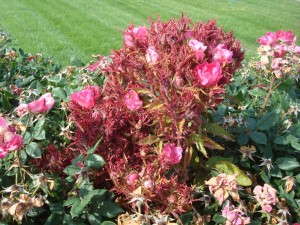Rose Rosette Disease Fight Gets A Boost From Government Funding

Rose Rosette on Knockout rose, May 2013. Photo credit: Alan Windham, University of Tennessee
With the help of federal funding, experts throughout the industry are working together to form a strategy for managing and mitigating rose rosette disease (RRD).
The U.S. Department of Agriculture’s National Institute of Food and Agriculture (NIFA) awarded $4.6 million in funding to address the garden rose pathogen.
The funding was provided through the Specialty Crop Research Initiative (SCRI), a Farm Bill program, which AmericanHort worked to improve in the 2014 Farm Bill, says Joe Bischoff, regulatory and legislative affairs director of AmericanHort.
Following the 2008 Farm Bill, many SCRI project proposals went unfunded due to a flawed review process, he says.
“We recognized there were some significant shortfalls, so, through the Farm Bill process, we were able to make significant changes for how that was evaluated,” Bischoff says. “I think those changes that we worked so hard to see happen in the Farm Bill — that’s the reason our industry’s so successful. It’s an incredible project proposal.”
Roses Are A Cornerstone Crop
RRD is caused by the rose rosette virus, which is transmitted by the mite Phyllocoptes fructiphilus, and it can kill a rose within two to three years of infection, according to Dr. Dave Byrne, Texas A&M AgriLife Research horticulturist.
“Garden roses, which form the cornerstone of the multi-billion dollar landscape industry, annually generate wholesale U.S. domestic bareroot and container production valued at about $400 million,” Byrne says.
Addressing RRD is crucial, because, aside from being one of the most important crops in the industry, roses are an iconic plant, Bischoff says.
“It’s certainly one of the top revenue producing crops in the industry. Roses are our national flower. There’s a patriotic connection,” Bischoff says. “If we don’t plan for the challenges this plant faces, what are we going to fight for?”
Battle Plans For Fighting RRD Are Industry Wide
The plan of action includes working with private rose breeders to identify and develop rose rosette resistant varieties. There have been 25 different varieties tested for resistance, but the hope is for there to ultimately be up to 400, Bischoff says.
For the short term, the plan is to refine mitigation strategies, prevent the spread of RRD and provide treatment, Bischoff says. Also, there has been extensive outreach and education, so the industry can stay informed and arm itself against the disease.
Bischoff says he believes that, for the industry, the issue of rose rosette disease is just as important as the issues surrounding pollinators.
“This is going to be one of the biggest ones for years to come,” Bischoff says. “It’s an opportunity to get over other hurdles.”
If researchers are able to breed resistant varieties, then plants may not have to be treated with pesticides, he says. It would send a message about sustainability.
The effort started in April 2013 with the industry-sponsored Rose Rosette Summit, which brought together various industry members, including regulatory agencies, academics and trade associations. The group discussed the issue to gain a better understanding of it from all sides, Bischoff says, and the framework for the plan evolved from there.
AmericanHort established a rose rosette website (RoseRosetteDisease.com), which serves as an outlet for communication about the disease and the action plan.
A 17-member national team of experts, led by Byrne, will collaborate with rose breeders in California, Pennsylvania, Connecticut and Wisconsin, and experts at the Plant Research Institute in The Netherlands.
Those stakeholders met in the fall to discuss the SCRI, and there will be another meeting held in April at University of California-Davis to further discuss the direction of the project.
In addition to the SCRI project, AmericanHort is looking into entering the National Clean Plant Network (NCPN), which was created to protect U.S. specialty crops, such as nuts, fruit trees and hops, from the spread of economically harmful plant pests and diseases.
“There’s been an interest in the industry in having a landscape crop in the group,” Bischoff says.
There are various National Clean Plant Centers throughout the U.S, such as at the University of California Davis and the University of Washington, that serve as a repository where varieties from all over the world are cleaned up.









